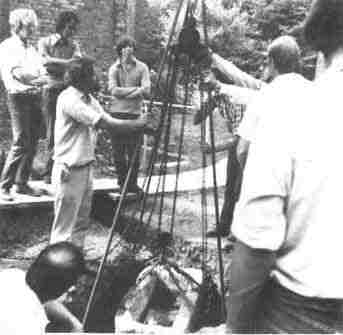|
4. Romano-British Burial Ground —East
Hill
The Group has carried out a series of excavations on East Hill,
Dartford. Knowledge of the Roman burial ground goes back to 1792, when
Thomas Brandon, a grocer of Overy Street, who also owned land on East
Hill, discovered the first of a number of stone coffins (sarcophagi).
More recently, in 1965, a disciplined archaeological
investigation was conducted by a team directed by Mr. J. Ritson, of
Dartford Borough Museum. This revealed thirty five graves as well as
evidence of an Iron Age settlement.
The Group’s researches on East Hill
started in 1973 when a further stone coffin was discovered, and in 1974
two training excavations in the grounds of East Hill Adult Education
Centre revealed further evidence of early occupation. The largest of the
excavations on the site, started in 1980 with the primary object of
re-locating the ‘grids’ previously dug by Mr. Ritson and his team.
(1) 1973 Excavation —
Workmen digging a trench for a feed pipe to the
basement boiler room of East Hill House, hit a large stone object. It
was noted that this seemed to be composed of Oolitic limestone which is
not found naturally in this area. The Principal of the Adult Education
Centre, Paul Coxon, readily gave permission for the Group to investigate
and during the following weekend the stone object was carefully
uncovered and photographed at each stage. When fully exposed, a child’s
coffin was revealed and it soon became apparent that it had been moved
from its original site during the last two hundred years.
The stone lid of the coffin was
missing, although the coffin rim plainly showed where the securing
cramps had been. There was no sign of the skeleton of the child. In the
bottom of the coffin were the remains of a gin trap set in a ‘set’
position. This was no doubt designed to catch the unwary archaeologists
expected to uncover the coffin in future years! Fortunately, however,
the spring mechanism had rusted away.
The coffin itself may have been first
discovered when the foundations for East Hill House were dug in the 18th
century and was perhaps broken open by the builder’s workmen, who then
moved it to the site where it was found.
The coffin measured some 1 .22m (4ft)
long, 0.66m (2ft) wide and 0.35m (l4ins) deep and weighed approximately
half a ton. It had clearly been made for the body of a child of about
five years of age. The Oolitic limestone could well have been imported
from the continent. The presence of this coffin and the earlier
discovery of large stone sarcophagi are clear indications that wealthy
Romans dwelt in Dartford.
(2) 1974 Excavations —
These two training digs were carried out as part
of a series of evening classes for would-be archaeologists and were
intended to produce trained supervisors. The excavations were carried
out on the west side of the pre-fabricated classrooms, with further
trial holes parallel to the western boundary and included two grids in
the woods to the north of East Hill House.
The main excavation revealed thirteen
graves, all in a roughly east-west orientation, of which two appeared to
|
|
have been wooden coffin burials, because large iron nails were found and
the grain marks in the rust showed that the planks were about 7cm (21/2
ins) thick. Fragmentary skulls were found in three of the graves but
these apart, very few bones had survived, due to the acidic nature of
the gravel.
The three fragmentary skulls rested, or were
'pillowed', on large flints. The alignment and the lack of grave goods
could indicate Christian burials. The graves in this area had been dug
through a scatter of Iron Age domestic debris indicating a settlement of
this culture had been sited nearby. Another major find was a flint hand
axe of Acheulian date lying on the surface of the gravel.
(3) 1980 Onwards —
The primary aim of this excavation was to relocate
the area previously examined in 1965. The Group has carried out this
work over the last six years with long absences made necessary by the
need to deal with more immediate threats to sites in other areas of the
town centre.
A number of the earlier grids have
been relocated but at present it has not been possible for the burial
pattern to be tied in with any certainty to the 1965 site plans.
Our excavations have yielded a
considerable number of
worked flints. ‘Pot boilers’ have also been recovered together with
Iron Age pottery sherds and potin coins.
A few of the Roman graves located by
the Group have contained complete vessels and several produced coffin
nails. The orientation of the graves varies considerably and their
distribution is irregular. The Roman pottery so far discovered on this
site indicates a date from the late 2nd century to 4th century.
The secondary aim of our work is to
locate the part of this obviously extensive cemetery that has produced
the stone coffins mentioned earlier. A useful lead in this quest was
obtained at the end of 1984 when a complete horse skeleton was
discovered. This find tied in very closely to a reference by John
Dunkin, to a horse burial made c1797. He mentions that whilst burying
the horse, a stone coffin was discovered and removed. Further work on
this area of the site may hopefully reveal previously unlocated coffins,
which could supply vital information about some of Dartford’s
wealthier Romano-British inhabitants. Romano-British child’s stone
coffin, East Hill House, 1973

Lifting Roman Stone Coffin |